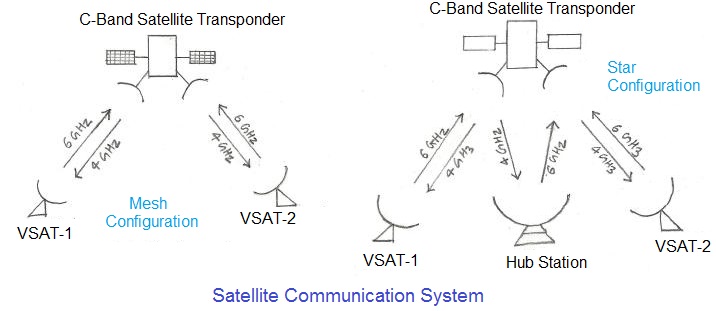
Refer satellite tutorial covering following sub topics:
Main Page About satellite Bands Parts Orbits Services Types capacity allocations network configurations Applications Remote sensing VSAT basics
Microwave frequencies are used for wireless communication as they penetrate ionosphere. They get attenuated when used as ground waves as well as surface waves. Due to this reason microwave communication is mainly LOS (Line of Sight) based communication.
Microwave communication systems are mainly classified into satellite systems and terrestrial systems. Both of these systems require transmit part and receive part. The transmit system converts baseband signal to microwave signal. The receive system converts microwave signal to baseband signal. The baseband signal is multiplexed signal which carries number of individual low bandwidth signals such as voice, data and video.Multiplexing is done either using TDM or FDM.
Terrestrial Communication System

Microwave frequency gets attenuated due to buildings, trees, geographical locations, hence the ground distance(i.e. range) is limited from one part of earth to the other. In order to extend the range of terrestrial communication system, multi section relays or repeaters are used.
The figure-1 depicts terrestrial communication system with two stations and repeater module. Multiple repeaters are used between source and destination stations. Repeater receives the signal from one end and amplifies and retransmits the signal to the other end. Hence repeaters will make up for the RF losses introduced due to path pass. Typically repeaters are placed at the distance of about 32 to 80 Km.
Terrestrial system uses both analog and digital modulation types. In analog systems, data information signals are frequency multiplexed(FDM) first and later modulated (FM) and up converted for the transmission using RF antenna.
In digital systems, data information signals are time multiplexed(TDM) to form baseband signal. This is later modulated (using either PM or PSK) and up converted for transmission using RF antenna.
Satellite Communication System

Figure-2 depicts satellite communication system. There are two modes of satellite based network viz. mesh and star. In general in this system, baseband information is transmitted at microwave carrier frequency using directional antenna from ground station (i.e. VSAT) to the satellite. Satellite receives the signal using on board antenna. It first shifts the received frequency to the other frequency band. Later it does amplification of the translated signal before being relayed over the large area of the earth.
As depicted in the figure 6GHz is used as uplink frequency and 4GHz is used as downlink frequency. Difference of 2GHz is carried out at the satellite transponder using LO frequency of value 2225 MHz. Here 6 GHz is the frequency range from 5.925 to 6.425 GHz and 4 GHz from 3.7 to 4.2 GHz. Refer function of satellite transponder.
Satellite frequencies are selected to overcome effects of ionosphere, absorption by gases and water vapour. Geo Stationary Satellite is placed at the height of 35800 Km. It travels at approx. speed of 11000 Km/Hour. Due to this fact, tracking of satellite is not required and fixed antenna at ground station is enough to establish RF link at all the times.
In mesh mode, VSAT1 and VSAT2 directly communicates using satellite. In star mode, VSAT1 and VSAT2 communicates using Satellite/Hub. Both configurations work at 6GHz(uplink) / 4GHz(downlink) bands. The other satellite system bands are Ku bands and works at 14GHz (Uplink) /11 GHz (Downlink) and 17/12 GHz frequency bands.
As mentioned in terrestrial system, repeater is used between source and destination stations. In satellite system, transponder is used to provide connectivity between source and destination stations. In general, satellite usually will have total 12 transponders each with 36 MHz bandwidth. The whole satellite band is usually about 500MHz.
Difference between Satellite System and Terrestrial System
There are a number of differences between satellite based and terrestrial wireless communications that affect design.
• Coverage area of a satellite based system is greater than that of a terrestrial based wireless communication system. A GEO satellite with one single antenna can cover about 1/4th of the earth.
• Satellite communications link will have more degradations compare to terrestrial communication link but quality of transmission is usually quite good.
• In a satellite link delay from earth to satellite to earth is about 240ms while in terrestrial link it will be far less. But transmission cost in a satellite system is independent of the distance within the area of coverage of the satellite antenna, while in terrestrial system it varies based on the distance.
• In a satellite based system satellite EIRP and bandwidth is very vital parameters which need to be carefully designed at the initial stage of both satellite and earth station point of view.
• Very high bandwidths and very high data rates are achievable in a satellite based communication system.
• In case of satellite based systems all the earth stations/VSATs can receive their own transmissions and hence transmitted power should be carefully decided based on the RF link budget. But both transmitting and receiving frequencies are different and hence will not create much problem. Transmit reject filter should be good enough to overcome this problem.
Useful Links
SCPC MCPC EPABX basics Satellite tutorial VSAT system basics FDMA vs TDMA vs CDMA FDM vs TDM
What is Difference between
difference between FDM and OFDM
Difference between SC-FDMA and OFDM
Difference between SISO and MIMO
Difference between TDD and FDD
Difference between 802.11 standards viz.11-a,11-b,11-g and 11-n
Bluetooth versus Zigbee
Fixed wimax vs mobile
wibro vs mobile wimax
Microcontroller vs microprocessor
CDMA vs GSM
OFDM vs OFDMA
wimax vs lte
RF and Wireless Terminologies
SATELLITE RF Antenna Avionics Wireless LiFi vs WiFi MiFi vs WiFi BPSK vs QPSK BJT vs FET PDH vs SDH CS vs PS MS vs PS
Share this page
Translate this page
ARTICLES T & M section TERMINOLOGIES Tutorials Jobs & Careers VENDORS IoT Online calculators source codes APP. NOTES T & M World Website

